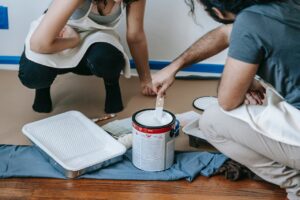There’s a certain allure to the idea of rolling up your sleeves, grabbing a paintbrush, and transforming your living space with a fresh coat of paint. The do-it-yourself (DIY) trend has gained considerable popularity in recent years, with homeowners taking on various projects to save money and add a personal touch to their homes. However, when it comes to painting, it’s often wiser to leave the job to professionals. Hiring a painting company can make a world of difference in the outcome of your project and spare you from potential DIY disasters. Let’s explore why it’s time to say goodbye to DIY and let a painting company handle your next painting endeavor.
Table of Contents
ToggleQuality Of Workmanship
When it comes to painting, the quality of workmanship is crucial in achieving a flawless and professional finish. Professional painting companies have experienced and skilled painters who have honed their craft over time. They understand the nuances of paint application, surface preparation, and techniques necessary to deliver a high-quality result. These experts know how to achieve even coverage, avoid streaks and drips, and ensure clean lines. Their attention to detail and precision can transform your space into a visually appealing and polished masterpiece.
Time And Efficiency
Painting a room or an entire house can be a time-consuming task, especially if you’re not well-versed in the process. While you may have the best intentions of completing the project quickly, it’s easy to underestimate the time it takes to properly prepare surfaces, apply multiple coats of paint, and clean up afterward. Professional painting companies have the experience and resources to efficiently handle painting projects. They can accurately estimate the time required, work within a set schedule, and complete the job promptly. By entrusting the project to professionals, you can free up your time to focus on other priorities while still achieving excellent results.
Surface Preparation
One of the critical aspects of a successful paint job is proper surface preparation. Neglecting this step can lead to a host of issues, including peeling, bubbling, or uneven paint application. Professional painters understand the importance of thorough surface preparation. They will inspect your walls, repair any cracks or imperfections, and ensure a smooth and clean surface before starting to paint. Their expertise in this area ensures that the paint adheres properly, extends its durability, and provides a consistent finish throughout your space.
Access To Professional Tools And Materials
While you might have a basic set of painting tools at your disposal, professional painting companies have access to a wide range of specialized tools and materials that can significantly impact the outcome of your project. From high-quality brushes and rollers to sprayers and professional-grade paints, these companies invest in top-notch equipment that yields superior results. They stay up-to-date with the latest innovations in the painting industry, allowing them to offer you the best solutions for your specific needs.
Cost-Effectiveness
Contrary to popular belief, hiring a painting company can be a cost-effective choice in the long run. While the initial investment might be higher than a DIY project, it is important to consider the overall value and benefits provided by professionals. By avoiding mistakes and redoing poorly executed work, you save money on additional supplies and materials. Moreover, a professional paint job enhances the overall aesthetic appeal of your home, potentially increasing its value and making it more attractive to potential buyers should you decide to sell in the future.
Insurance And Warranty
Another advantage of working with a painting company is the protection provided by insurance and warranties. Reputable painting companies carry liability insurance, which covers any accidental damage that may occur during the painting process. This gives you peace of mind, knowing that you are protected in case of any unforeseen mishaps. Additionally, many professional painters offer warranties on their workmanship. This means that if any issues arise after the completion of the project, they will rectify them without any extra cost to you.
In conclusion, while the allure of DIY painting projects may be enticing, entrusting your project to a professional painting company can save you time, money, and headaches in the long run. Their expertise, attention to detail, and access to professional tools and materials ensure a high-quality result that will transform your space. So, say goodbye to DIY disasters and let the experts handle your painting project. Sit back, relax, and enjoy the benefits of a beautifully painted home.
Transform Your Space With Paintmasters: Your Premier Painting Company Since 1994!
Are you ready to breathe new life into your home or office? Look no further than PaintMasters, the leading painting company serving Concord, California, and the surrounding areas. With over two decades of experience, our team of experts is here to bring your vision to life.
Why choose PaintMasters? We pride ourselves on staying ahead of the curve with cutting-edge technology and state-of-the-art facilities. Our impressive 15,000 CFM spray booth ensures that your cabinets will receive a flawless finish that will leave you speechless. We’ve got you covered from interior and exterior painting to custom homes, decks, acoustic removal, drywall repair, and texturing. Our skilled professionals will make sure the job is done right the first time, so you can sit back and enjoy the transformation.
But that’s not all – we go beyond just painting walls. PaintMasters specializes in staining interior and exterior walls, cabinets, doors, decks, and other woodwork. Whether it’s a residential project or a commercial endeavor like office spaces or restaurants, we bring a touch of style and elegance to every surface we work on. Our unique blend of design instinct and technical skill ensures professional results exceeding your expectations.
Don’t let a tired room bring you down. Let PaintMasters unleash its magic and create a space that reflects your personality and style. Imagine the joy of walking into a room transformed by our expert painters. It’s time to make a statement and leave a lasting impression.
Ready to take the first step? Contact PaintMasters today for a free estimate. Our friendly team is eager to assist and guide you through the process. Whether you call us or request an estimate online, we’re here to make your painting dreams a reality.
Refresh, renew, and revitalize with PaintMasters – your trusted partner for all your painting needs. Transform your space and let your imagination soar. Contact us now and let’s get started on your next masterpiece!


